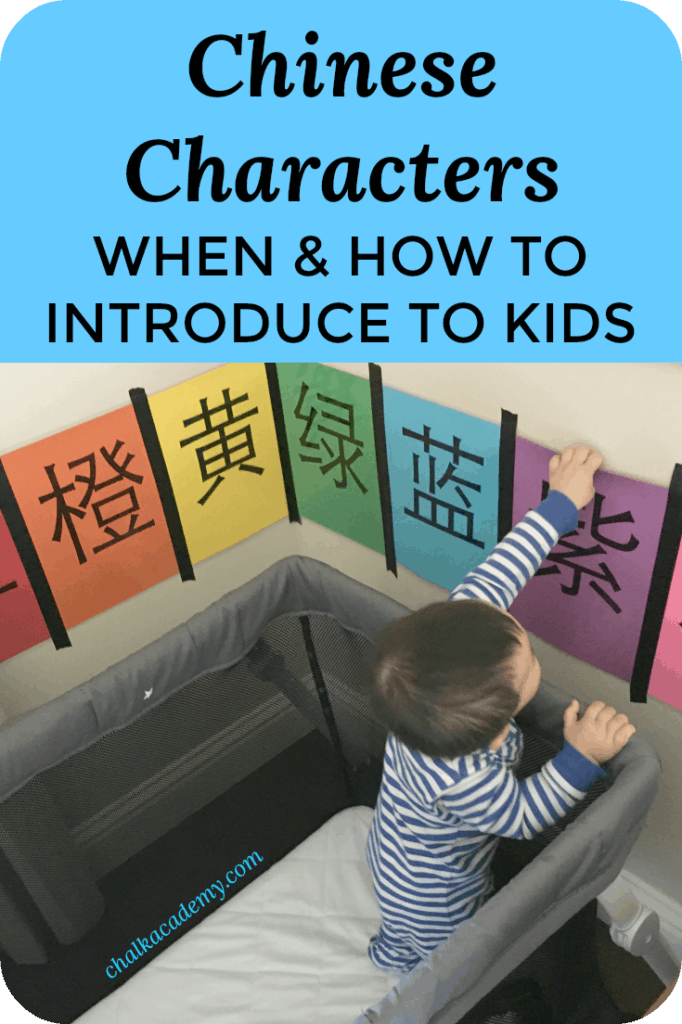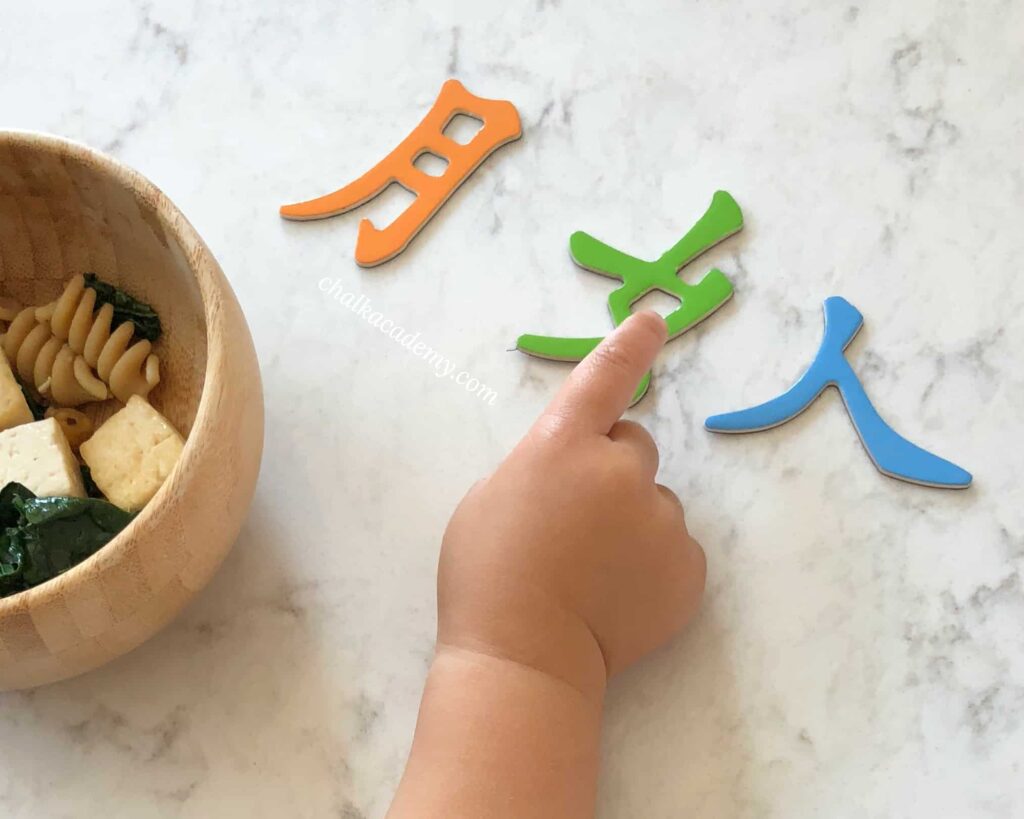When and How to Teach Chinese Characters to Kids?
What is the best time to introduce and teach Chinese characters to children? Although kids develop observation and listening/speaking skills before text recognition, early exposure to Chinese characters in a positive and immersive way sets the stage for learning.

How to teach kids Chinese characters
This post is part of a series on teaching kids how to read Chinese:
- When and How to Introduce Chinese Characters to Kids? (This article)
- 15 Ways to Encourage Your Child to Read
- Create a Print-Rich Environment with Labels that Promote Literacy
- How I Taught My Daughter to Read 1000+ Chinese Characters as a Non-Fluent Parent
- When Should My Child Learn Hanyu Pinyin?
Chalk Academy is reader-supported. Some of the links are affiliate links. When you buy something through an affiliate link, we may earn a very small commission at no cost to you. Details here.
When is a child ready to learn Chinese characters?
In China and Taiwan, children see Chinese characters everywhere! It’s never too early to introduce Chinese characters in the home environment.
However, this does not mean it’s time to pull out workbooks and textbooks for formal sit-down lessons.
Generally, children between ages 3-6 years begin to develop pre-reading and reading skills, though some children may be ready earlier or later than that range.
Just as you can’t make a baby walk at nine months, you can’t force a child to read before they are ready.
Instead, you can be observant of their sensitive period for reading and cultivate the following skills:
- Interest
- Attentiveness
- Print awareness
Explore this: Luka Reading Robot is a Game Changer for Bilingual Families
How to get kids interested in learning and reading Chinese
Read, read, and read Chinese books with your child!
Turn off smartphones, iPads, and TVs so that you are modeling uninterrupted interest in reading with your child, and have Chinese books throughout the house and in the car!
While most beginner books have few words, you can expand upon the script by discussing the illustrations in your own words.
Kids are naturally drawn to pictures! Intermittently, point out that the text on the page represents pictures.
Other ways to increase exposure to Chinese print
- Create large Chinese signs around the house
- Label items around the house
- Play with toys labeled with Chinese characters
How I knew my kids developed print awareness
When my firstborn daughter was ten months old, she asked about text while we looked at baby board books.
Before she could speak, she would make a”Mmm mmm?” sound and point her little finger at letters and numbers over and over again.
By age 18 months, she knew how to hold a book upright, point to, and say numbers and English letters (upper and lower case).
At age 2, she quickly learned the Korean alphabet and would point out shapes in nature and buildings that appeared similar to letters.
She also began to learn a few simple Chinese characters at that age.
On the other hand, my son seemed oblivious to print until he was age 2 years.
He first showed interest when he picked up my daughter’s Korean Hangul letter toys and Chinese puzzle magnets and asked a short phrase, “什么字? (Shénme Zì? / What letter?)”
However, sometimes, he still has to be reminded about the correct way to orient books!

How to improve attention span in children
Attention spans in young children are quite variable, especially before age 6, but concentration is a skill that can be improved with practice.
Children build attention skills through various activities in their daily routine, like putting away their toys, buttoning clothes, counting and calculating, and drawing a picture.
Give your child ample time to work on something that captures their attention.
In addition, identify factors that reduce focus and remove those obstacles.
Common causes of decreased attention
1. Parental interruptions
Parents often feel they need to help their children and rush to “fix” things.
If your child shows interest in doing something that is not dangerous, you can observe quietly while he or she figures out a solution.
Another common problem is that parents will try to redirect their child from something that they think is not important for a child to do.
Again, if there are no safety concerns, let your child explore it!
Children need to develop the confidence to try things independently.
2. Environmental clutter
Excessive toys (too many options!) and screen time commonly detract from a child’s attention.
3. Internal distractions
Attention may lapse due to hunger and fatigue.
Make sure your child has a healthy snack or meal before they get too cranky.
In addition, breaks and restful nighttime sleep are important for restoring energy.
4. Inappropriate learning material
Children may lose focus if the task is too hard or easy for their developmental level.
For example, the information may be overwhelming if you try to teach a child to read Chinese characters without first establishing listening and speaking skills.
Remember that children begin to learn in short chunks (eg, minutes) and build stamina over time.
Teach kids Chinese with strategies that encourage print awareness
Before children learn to read, numbers, letters, and characters are abstract shapes and designs.
Gradually, you can help your child make the connection that words represent concepts.
Point out words
- When reading picture books with your child, use your finger to point out pictures and words related to the picture. That being said, if your child is enjoying their time with the illustrations, don’t interrupt or rush her exploration. You can quickly point out a Chinese character when they are ready to turn the page.
- Stop and look at the signs and labels that you have created around the house! If you live in a Chinese-speaking country, look for familiar characters on public signs.
Write for your child
- Handwriting lets children see how Chinese characters are formed.
- Use different writing utensils such as pencils, pens, markers, paint, chalk, etc for variation!
Interact with Chinese characters
Since print is 2-dimensional, children may benefit from tangible ways of learning Chinese.
- Feel:
- For all ages, Chinese character puzzles allow kids to feel the whole character in their hands.
- Children age 3+ who can follow directions may benefit from tactile letters and tracing boards which give tactile input while tracing Chinese characters. Montessori schools typically introduce Chinese sandpaper letters in the 3-6 classroom.
- Trace & Build:
- Use playdough, Legos, twigs, stones, pipe cleaners, or any object to create Chinese characters!
- Match:
- Ask your child, “Which characters are the same? Which are different? What differences do you see?” This takes the pressure off memorizing Chinese characters; instead, it lets a child take time to compare and contrast characters.
- Older kids may enjoy puzzles of Chinese words cut up into pieces and put back together.
- Play:
- When my son learned the character 车 (chē / car), we zoomed the Chinese character all around the house! When he learned 刀 (dāo / knife), we pretended to cut things with that Chinese character!
Try this: 有道 Youdao Chinese Dictionary Pen
Example of Chinese character matching activity
Here’s an example of my 5-year-old daughter teaching my 25-month-old son Chinese characters 水 (shuǐ / water) and 雨 (yǔ / rain).
Notice that she first asks my son which characters are the same and different. After he has mastered this, she asks him to point to the matching character.
Which Chinese characters should I teach first?
3 general rules for choosing first Chinese characters:
- Characters with few strokes
- Words that your child speaks in Chinese everyday and understands the meaning
- Concepts that intrigue your child (eg, family members, nature, hobbies)
Start with one simple character and build his or her confidence over time.
Since my son knows his colors well, I put different colored 口 (kǒu / mouth) on a tray.
After a few days, he said, ” 妈妈,太容易了! (Māmā, tài róngyìle! / Mama, too easy!).” Then I knew he was ready for more.
However, if your child does not know colors yet, it could be confusing to know which concept to focus on.

Although Chinese numbers are among the most simple Chinese characters, my son does not know how to count.
In contrast, my daughter understood the concept of numbers and counting at a young age. Therefore, Chinese numbers were the first characters that she learned.
On the other hand, while my son has been exposed to Chinese numerals, I am not worried about teaching number recognition.
A strong understanding of a concept is an important prerequisite to learning the symbolic representation.
Another example is that 士 (shì / soldier) is a similar character to 土 (tǔ / soil), both with only 3 strokes. 土 is an excellent word to teach early because kids can see and touch dirt at the park or in the yard! Since my children have never seen a soldier, 士 is an abstract concept.
Try this: Positive Affirmations to Tell Our Kids Everyday (English / Chinese Printable)
How NOT to teach your kids Chinese…
- Don’t forget that life is short, and kids must have fun! If they have no interest in learning characters yet, that’s okay. Continue to encourage observing, listening, and speaking skills.
- Please don’t criticize your child if they cannot remember Chinese characters. Be patient and mindful that negative associations can quickly deflate interest and motivation.
- Don’t introduce too many characters at a time! Plastering your house with large Chinese flashcards does not mean your child will learn more characters. Instead, focus on a few relevant Chinese characters and rotate in new characters.
- To poke fun at my photo, posting colorful Chinese color names next to your baby’s bed will be very distracting! These colorful papers were on the wall briefly because the colors were too stimulating for my son to sleep. He tried to rip it down many times! Soon after removing the papers, my son’s sleeping space returned to peace and calm. To reiterate a prior point, sleep is sacred and necessary for adequate attention 🙂


0ear Betty,
Your Chinese lessons and advice are wonderful and accurate. I am grateful for finding you and your children on Pinterest.. You are thorough and give good information on finding Chinese reading materials. Thank you.
I am an “old shoe” Montessorian .who has spent 13 years in China doing bi-lingual, Chinese/English, a rich experience. Currently, I am in Honolulu, Hawaii for dental work and I also would love to set up class for kindergarten- primary in bi-lingual English -Chinese, working with
a Chinese person. Covid created a few complications for my plan. 明白?
I will continue to read your lessons and advice from the Chalk School as I pursue my plan.
I would be honored to meet you and your wonderful family.
Best regards,
Ann Doyle
I found your blog while browsing google search result. It is very inspirational. Thank you for all these helpful tips. I am mum of twins of 3.5 years old. We are also multi-language family (Chinese-Spanish-English). I haven’t introduced any Chinese character to my kids yet because I was worried if it would cause confusion to them. After reading your articles, I decided to begin their Chinese learning journey. Thank you!
Hi Maggie! Thank you for taking the time to write and share about your family! I’m so excited that you’ve decided to start teaching Chinese to your twins, and that’s awesome they are also learning Spanish and English! Please let me know if I can help along the way!
Wow! Your daughter is now a 小老师! 从妈妈老师学来的! This post is beneficial especially for those with young. Will be sharing with my friends who has such learning opportunities! Meanwhile I shall persevere in teaching my kids with lots of Chinese books. Thanks for the inspiring post 1. Looking forward to part 2.
Thank you so much for your encouragement, Angie! 🙂